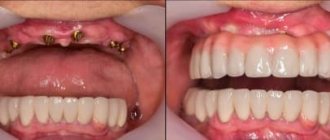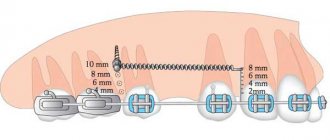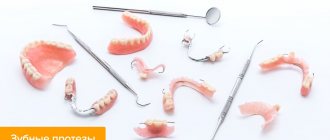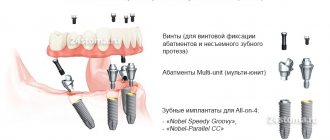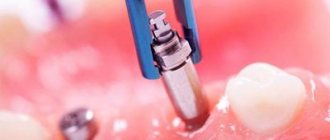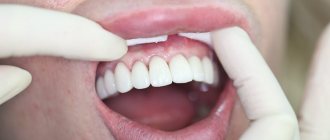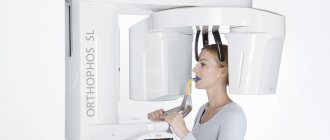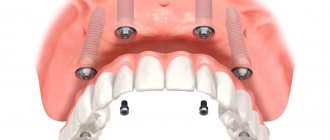More than 7 million people around the world have received dental implants to restore one, several or all teeth. Dentures on implants are a reliable, safe and well-researched method of restoring the aesthetics and functionality of the dentition: you can smile beautifully again and eat your favorite food without restrictions.
For those planning to install implants, we have prepared answers to the following questions:
Contraindications for installing titanium rods
Does it hurt during implant placement?
Installation stages (step by step with deadlines)
What not to do after installation?
What complications can there be after implantation?
Guarantees for implant installation
Contraindications
| Absolute (operation impossible) | Relative (the operation is temporarily postponed) |
|
|
Does it hurt during implantation?
All procedures are carried out under local anesthesia, so the patient does not experience any painful sensations - he only feels the mechanical work of the doctor in the mouth, as during conventional dental treatment. In fact, the manipulations performed when installing an artificial root are less invasive and traumatic than when removing a tooth.
If you are very worried and are terrified of the upcoming operation, the clinic may offer implantation under sedation - in a relaxed state, but in full consciousness. The patient is given drugs that put him into a light sleep and he ceases to experience anxiety.
Put crowns on teeth: prices in Moscow
How much does it cost to put a crown on a tooth - the price in Moscow for 2021 (in economy-class and mid-price clinics) can have a very wide range. For example, you can easily see that in one clinic you can install a dental crown made of metal ceramics for 5,500 rubles, while in another the price can be 10,000 rubles. And it’s not just a matter of pricing...
The fact is that the same crowns (for example, metal-ceramic) can be made of materials of completely different quality. For example, if a cheap ceramic mass is used, then we can immediately say that the aesthetics of such a crown will be very poor. In addition, in addition to standard metal-ceramics, there is also “metal-ceramics with shoulder mass”, which is much more aesthetically pleasing than the standard version, but at the same time costs 2-2.5 times more.
Installing a crown on a tooth: price 2021
- metal ceramics - from 4,500 to 16,000 rubles.
- ceramics made of zirconium dioxide – from 14,500 to 20,000 rubles.
- from E.max ceramics – from 16,000 to 25,000 rubles.
- all-metal crowns – from 4500 rubles.
Important: if you are planning to install a crown on a tooth, the cost above does not include all possible expense items. Additionally, therapeutic preparation of teeth (if necessary) is paid, as well as the cost of making temporary crowns made of plastic. The latter are necessary to protect the ground teeth while your permanent crowns are being made.
Stages and deadlines
1. Initial appointment (up to 20 minutes).
The implant surgeon gets to know the patient. Visually examines the oral cavity, assessing the current health of teeth and gums. To exclude the presence of contraindications and analyze the possible risks of complications after implantation, the doctor collects an anamnesis - information about the patient’s living conditions, diseases, bad habits, pharmaceuticals taken, etc. Answers any questions that may arise.
In what cases is it recommended to undergo tests before implantation?
Additional examination is necessary if the patient:
- has a chronic disease;
- undergoing any treatment;
- in the last 1-2 months, suffered from a serious illness or underwent surgery.
2. Comprehensive hardware diagnostics (up to 30 minutes).
Includes:
- Sight shot
. Necessary for assessing the condition of teeth located adjacent to the implant installation site. Detects inflammatory processes at the apex of teeth, hidden fractures/root injuries. Helps assess the quality of installed fillings (if any). Eliminates the risk of infection from neighboring teeth getting into the socket when an artificial root is implanted. - Panoramic photo (orthopantomogram)
. This three-dimensional image allows you to visualize the upper and lower jaws in an expanded plane. OPTG helps the doctor give an initial assessment of the condition of each tooth, its canals and roots, periodontium, maxillary sinuses, sinuses and other structures of the dental system. - CT (computed tomography)
. Allows you to study in detail the required area of the jaw in any plane at the required angle. Reveals hidden inflammatory and pathological processes in the periodontium. Helps to select the optimal dimensions of the titanium rod, as well as the installation location. Eliminates damage to the maxillary/mandibular nerve and blood vessels during implant installation. Provides important information for 3D modeling of the surgical process.
3. Computer modeling (2-3 days).
Three-dimensional visualization allows the implant surgeon to calculate and see the result of treatment before it begins.
The software helps the doctor determine the optimal locations for installing implants, taking into account the density and volume of bone tissue, select a titanium rod model, and calculate the angle and depth of implantation. The human factor is excluded, the result of implantological treatment is calculated with high accuracy. 4. Preparation (sanitation) of the oral cavity.
Before implantation, it is important to carry out professional dental hygiene (cleaning from plaque and tartar), eliminate existing inflammatory foci, and cure dental diseases identified during diagnosis (caries, pulpitis, etc.).
Jaw implantation using All-on-4 or All-on-6 technology also requires the preliminary removal of existing teeth, since a complete fixed prosthesis of 12 or 14 crowns is installed.
5. Osteoplasty.
If there is insufficient bone tissue volume, before installing a titanium rod, one of the following methods is used to build it up:
- Alveolar ridge clefting
. The doctor makes a cut into the alveolar process (the part of the jaw into which titanium screws are implanted) and increases its thickness using artificial bone material or graft. Installation of the implant is possible after 4-6 months. - Guided bone regeneration
. During the operation, the doctor places a synthetic bone analogue into the jawbone and covers it with a protective membrane. The patient's blood plasma is used to stimulate bone tissue growth. Implantation is possible in 3-6 months. - Sinus lift
. The volume of bone tissue in the area of the maxillary sinuses increases. There are open (more extensive surgery used for severe bone atrophy) and closed sinus lift (less invasive, with a slight lack of bone height).
Our clinic uses Straumann Roxolid implants, which allow us to avoid bone grafting in 95% of clinical situations, both when restoring one tooth and during total prosthetics of a toothless jaw!
6. Surgery (15 minutes).
Under local anesthesia, the doctor makes an incision in the gum and lifts flaps to gain access to the jawbone.
Then he prepares the implantation bed by drilling a hole of the required depth in the bone. After checking the depth of the canal with special tools, the implantologist bores it to the required width.
A titanium rod is implanted into the resulting hole. Its model, length and thickness are selected at the 3D modeling stage.
The implant is closed for 2-6 days with a plug, which protects the artificial root from microbes and mechanical influences.
The gum is sutured, closing the temporary plug.
On days 3-7 after implantation, the sutures are removed and an abutment is installed.
7. Orthopedics.
It takes place in two stages. At the first visit, an impression is taken within 20-30 minutes, on the basis of which a temporary crown will be made in the dental laboratory. At the second visit (after 2-3 weeks, depending on the clinical picture), the prosthesis is fixed to the abutment (duration - up to half an hour).
Age of patients for the All-on-6 technique
For “all on 6” implantation, this is, of course, the older age group. Mostly people over 45 years of age come to us. When there is talk about implantation “all on 6” - there is practically no upper limit.
Here is an example of total prosthetics for a 70-year-old patient whose initial situation was as follows:
And the result of his prosthetics is presented in the following picture:
The oldest patient we did this kind of work on was 87 years old, and everything went very well, thank God, both for the patient and for us. Well, in principle, this technique can be used even from the age of 20, if there is a need for it, but often in patients at the age of 20, all teeth are present and everything should be fine.
Recommendations after All-on-6 implantation
After installing the structure on “all-on-6” implants, the patient is usually recommended the same recommendations that we give after any implantation - it is necessary to take either 5 or 7 days of antibiotics, baths with an antiseptic, when the patient holds an antiseptic in his mouth to muffle the flora.
Among the special recommendations is the recommendation not to eat hard or viscous foods. Well, of course, immediately after implantation you should not overload them, try to chew the steak and overload them. Everything should be soft and easy to chew so as not to overload the implants that are installed in the patient.
Are there permanent restrictions after All-on-6 implantation?
There are no restrictions as such. The patient is only not recommended to do what is not recommended to do with his teeth - try to crack nuts, rip off the insulation from wires, although patients “sin” in that due to the fact that the implants are tightly fixed into the bone, they do not have the same teeth as teeth. , no periodontal ligament. And when we create a load, we can develop a much greater force than with our teeth, and some patients forget when they have had these structures in place for a long time.
I had a patient who chewed an olive pit, although I don’t know how this could have occurred to him, but he did it, but he chipped the ceramic that was on the zirconium prosthesis and had to do a restoration.
Implant installation methods
Installing implants allows you to replace missing teeth with new ones that are practically no different from natural ones. Today, there are several main options and ways to install an implant.
Classic implantation
Classical implantation allows you to insert implants in any quantity, even in the absence of teeth in the oral cavity. This process is very lengthy, however, in the end it gives an excellent result. The chewing function and aesthetics of the smile are completely restored. At the first stage of implant installation, artificial roots (the basis of the implants) are implanted into the bone tissue. Then the abutments (support for the crown) are implemented, and only after that it becomes possible to place a dental implant.
One-stage implantation - we will place the implant immediately after tooth extraction
In some cases, an implant can be installed immediately after tooth extraction, without waiting for the tissue to heal. This option allows you to prevent bone tissue atrophy, however, the operation can be performed only in the absence of any acute diseases of the teeth and gums in the patient.
Express implantation
In the case of express implantation, the implant and crown can be installed immediately after it is implanted into the bone. Place an implant
This method is possible provided that one or more teeth located at a distance from each other are restored. A combination of express implantation with other methods is often practiced, provided that express is used for the front teeth. It is possible to place a dental implant using the express method, provided that inflammatory diseases in the patient’s oral cavity have been treated, and there is no need to build up bone in the place of the missing tooth.
What is a beam prosthesis?
The peculiarity of the beam prosthesis is the method of its fixation. The fastening element consists of two parts - a beam and a semicircular metal pipe. The beam connects the implants, the pipe is inserted inside the prosthesis. When fixed, it is put on the beam and latched with a special lock.
Bar dentures are conditionally removable; for daily hygiene it does not need to be removed from the oral cavity. The structure should be removed when visiting the dentist for thorough cleaning or replacement.
Recommendations after implant installation
- During the first 2-3 hours after surgery, eating is strictly not recommended. What happens if you neglect this? Disastrous consequences include: sutures coming apart, infection of the titanium rod installation site, biting the tongue or cheek.
- On the day of surgery, you do not need to brush your teeth or rinse your mouth. Starting from the second day, you can clean them, but with a soft brush. It is better not to touch the operated area. You can also rinse your mouth with an antiseptic solution after eating, but very gently.
- For the first two to three days, you should strictly not consume hot/cold food or drinks. It is recommended to exclude sour and spicy foods from the diet. You can eat broths, yogurt, and pureed foods.
- For 2-4 weeks, avoid air travel, saunas, increased physical activity, and hypothermia. Otherwise, the risk of implant rejection increases.
- Completely stop smoking and drinking alcoholic beverages for at least five days. During the period of osseointegration of implants (3-6 months), reduce the number of cigarettes smoked to a minimum.
Compliance with the following rules will not only help shorten the rehabilitation period, but will also minimize the risk of complications.
Flaws
- The operation takes a long time. The prosthesis can be installed only after complete osseointegration of the implants, and this requires about six months.
- Some modern materials are not suitable for the manufacture of bar prostheses.
- The beam is made of metal, so some patients may experience an allergic reaction. Such situations are a special case of contraindications (individual intolerance to materials). In most cases, modern dental alloys do not cause allergies.
- High cost of bar denture design. Despite the fact that restoring the dentition in this way is cheaper than classical implantation, the prosthesis is expensive.
Complications - when should you see a doctor?
If you experience any of the following symptoms, contact your doctor as soon as possible:
- After the 3rd day of surgery, pain gradually increases
. It is quite normal to experience minor pain for the first 2-3 days, but no more. - On the 4th day the swelling began to increase with an increase in body temperature
. Normally, it should subside on the third day. If it grows, then there is a problem. - After 4-5 hours, the surgical wound continues to bleed
. Minor bleeding in the first 2-3 hours is normal. But you should be wary if the wound continues to bleed. - Part of the face became numb, and there were difficulties opening the mouth
. This is due to stretch/compression or injury to the nerve. It occurs very rarely (in less than 3% of patients) and is associated with physician error. - The temperature rose sharply to 39° on the fourth day
. An increase in body temperature to 38° in the first three days after surgery is a completely normal reaction of the body to surgery. But if after three days you notice a sharp increase in temperature, then you need to consult a doctor. - Purulent discharge appeared from the implant site
. This indicates the presence of an inflammatory process due to infection of the hole.
How new dental implants are made and inserted if they cannot be placed without bone grafting
Dental plastic surgery involves increasing the volume of soft tissue on the gums when they are not enough. There are two ways to do this:
- Immediately transplant soft tissue if there are no contraindications during surgery.
- Natural growing and dividing the surgical procedure into two parts a few months apart.
This formation is necessary to give the jaw an attractive appearance and adjust the future smile accordingly. This issue becomes especially relevant when it comes to the front incisors, which are always in sight.
Answers to popular questions
Is it possible to install implants for diabetes?
Controlled diabetes mellitus is not a contraindication to dental implantation. Based on the results of the analysis for glycated hemoglobin, patients are divided into three groups:
- less than 6% - dental implants can be placed without any restrictions;
- from 6% to 8% - implantation is possible, but with minimal risk (special preparation is required);
- more than 8% - surgery is possible only after the patient reduces the level of glycated hemoglobin to the required levels.
The Family Dentistry clinic successfully performs dental implantation for diabetes mellitus according to an individual treatment plan, taking into account the specific clinical picture. We try to use technologies that allow us to avoid bone grafting - the operation is less invasive (traumatic), and healing is easier. In addition, we install Straumann implants with the hydrophilic surface SLActive, which eliminates blood supply disturbances in diabetes and promotes successful osseointegration in bone tissue.
Is it possible to place implants with periodontitis or periodontal disease?
Yes, you can. But treatment is required first, incl. Possibly gum and bone grafting.
With periodontitis, bone tissue atrophies, so osteoplasty may be required at the time of implantation of a titanium rod into the jawbone. Some clinical situations allow you to install an implant immediately after gum surgery for periodontitis, while others require up to 6 months for the bone material to engraft.
In patients with periodontitis, the gums are less dense and decrease in width and height. This is dangerous because a pocket may form between the neck of the implant and the gum, in which bacteria will accumulate. As a result, there is a high risk of titanium screw failure. That is why the dental surgeon first performs gum surgery.
What anesthesia is used to place dental implants?
Local anesthesia is most often used. It is enough so that the patient does not experience any pain when installing implants. A combination of local anesthesia with sedation (a state of drug-induced semi-sleep) helps to cope with the experience.
It is important to understand that the jawbone is not innervated. Therefore, it is necessary to numb only the mucous membrane, which local anesthesia copes well with.
Why does an implant take root faster when installed in the lower jaw than in the upper jaw?
Yes, titanium rods implanted in the lower jaw take root within 2-4 months, and in the upper jaw - from 3 to 6. This is due to the fact that the mandibular bone tissue is more dense.
What are the dangers of smoking after implantation?
Until about 10 years ago, smoking was an absolute contraindication to the installation of implants, and many dental clinics simply refused such patients who were at risk.
Nowadays, even heavy smokers are implanted, but smoking remains the worst enemy of dental implants. It promotes the growth of bacteria in the mouth and accelerates the formation of plaque. It also leads to irritation of the mucous membrane and constriction of blood vessels, slowing down the healing process of tissues after surgery. Thus, smoking not only significantly slows down the process of engraftment of artificial roots, but also increases the risk of their rejection.
Can I drink alcohol after getting dental implants?
It is advisable to avoid alcoholic beverages not only while taking antibiotics after implantation, but also for the entire period of osseointegration (i.e., 3-6 months) for the following reasons:
- irritates the mucous membrane, slowing down the process of engraftment of the titanium rod;
- dilates blood vessels, causing bleeding at the site of implantation of the artificial root;
- increases the risk of developing hematoma.
Still have questions about installing implants? Get a free consultation with an implantologist.
| Expert, author of the article: Akhtanin Alexander Pavlovich Orthopedic dentist, implantologist 35 years of implantation experience Material updated: October 11, 2022 |
Which clinic to choose
You can get dental implantation in Moscow at one of the ROOTT MCDI clinics. Installation of a two-stage ROOT implant (Switzerland) at the Moscow Center for Dental Implantology will cost 32,000 rubles. (excluding the cost of the crown), express implantation ROOTT – 44,000 rubles. (together with a temporary crown). You can learn more about the implantation technologies used in order to choose the most preferable option and have an idea of what to be prepared for at a free consultation with an implantologist. Appointments can be made by phone or online.
Modern dentistry offers a number of methods that give patients a chance to regain their beautiful smile. Every year, implant treatment becomes more popular and accessible.
In some cases, when it is necessary to remove a patient's own tooth, most often in the case of front teeth, dentists have the option of inserting an implant into the socket immediately after extraction. Then a “temporary” crown can be installed, thanks to which the patient maintains dental aesthetics, speech and chewing function. After about three months, the temporary crown is replaced with a permanent one, made by a technician in a laboratory. Single-stage implants themselves are slightly different in price from those that are loaded with delayed loading.
You can get advice from experienced specialists about dental implantation in the smile zone in the capital’s dental clinics:
| Clinic address | Clinic | Price |
| Dentistry ROOTT |
|
| Moscow, Kolpachny lane, 6, building 4. | Dentistry Sandora |
|
| Dentistry Prosmail.RU |
|
| Moscow, metro station "Butyrskaya", Rustaveli Street, building 15 | Dental Clinic Dention |
|
| Moscow, metro station Barrikadnaya st. Zoologicheskaya, 2, under. 9 | Dentistry DENTAL DREAM |
|
| Moscow, Zvenigorodskoye sh., 7 | Dentistry Implant Expert | Nobel implantation, USA, from 50,000 rubles, Astra Tech implantation, Sweden from 47,200 rubles, OSSTEM Korea - 27,000 rubles |
| Moscow, Bolshoi Sergievsky lane, 5 | Dentistry Viva-dent | Dental implantation depending on complexity: 31,000 - 41,000 rubles per 1 tooth |
| Moscow, st. Molodtsova, 2a | Family discount dentistry | Implantation is carried out using various systems - Astra Tech (Sweden), Ankylos Densply (Germany), Dentium (Korea), the price for 1 restored tooth is from 30,000 rubles. |
| Moscow, Paveletskaya sq., 1 | Dental Clinic Denta VIP | Implantation of the IMPLA system (Germany), OSSTEM (Korea) - from 36,000 rubles. Astra Tech (Sweden) – from 45,000 rubles. |
| Moscow, st. Lyublinskaya, 161 | Dentistry PRESIDENT |
|
Dental implants are the latest technologies that provide exceptional comfort of use. Patients who have lost their front teeth due to an accident, tooth decay, or other diseases can enjoy the ability to function normally and smile without fear, without discomfort, thanks to dental implants. The most modern method of replacing missing teeth is implantation.
Dental implants are placed when we lose our natural teeth. Most often, the decision to replace missing front teeth is made for aesthetic reasons. It's no secret that missing teeth can lead to changes in our appearance, or rather, facial features. You can see the appearance of your cheeks, mouth and nose change. Wrinkles appear faster in the middle part of the face, which makes us feel unattractive.
However, it is worth remembering that from a medical point of view, the replacement of missing teeth, both front and back, is very important. The absence of teeth disrupts the functioning of the chewing system, which over time affects both aesthetics and our health. The absence of molars causes improper grinding of food, which leads to the development of diseases of the digestive system, such as peptic ulcers or increased stomach acidity.


